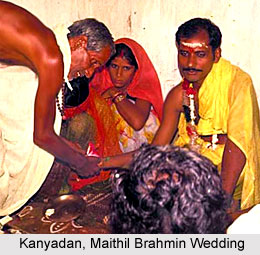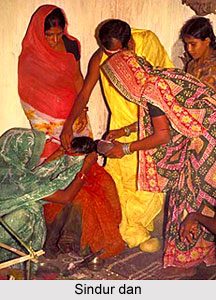 The word Mithila instantly brings in one`s mind the name of Janak putri or Sita. Ramayana is one of the greatest Indian epics and also a prime spiritual scripture that narrates the story of Ayodhya prince Ram and Mithila girl Sita. The place Mithila lies in the area of North India lying between the lower ranges of the Himalayas and the Ganges River. The border of Nepal intersects across the top periphery of this region. Gandak and Kosi Rivers form the western and eastern boundaries of Mithila. Both the rivers are distributaries of the legendary Ganga.
The word Mithila instantly brings in one`s mind the name of Janak putri or Sita. Ramayana is one of the greatest Indian epics and also a prime spiritual scripture that narrates the story of Ayodhya prince Ram and Mithila girl Sita. The place Mithila lies in the area of North India lying between the lower ranges of the Himalayas and the Ganges River. The border of Nepal intersects across the top periphery of this region. Gandak and Kosi Rivers form the western and eastern boundaries of Mithila. Both the rivers are distributaries of the legendary Ganga.
Maithil Brahmins are known to be the highest-ranking caste and they put into effect praiseworthy political power. As the Maharaja of Darbhanga was a Maithil Brahmin, other Brahmins also began dominating the Maithil kingdom. They became the principal landowners in Mithila. Mithila province like the rest of the regions in Bihar celebrates the Chhath Puja in which they invoke the blessings of the Sun God. Also, they celebrate the prime Indian festivals of Ramnavami, Dussehra, Diwali and Holi with great enthusiasm and extravagance. Their conventional idea with their penchant for festivities marks their marriage ceremonies also.
For a Maithil Brahmin, Kanyadan or offering the gift of a girl in marriage is alike the gift to a god. The daughter is very dear to her parents but not for keeping. It is in fact the best gift that a man can ever give. Howsoever he might love her, he would not be able to keep her.
Marriage is a conventional affair for the people of Maithil Brahmin sect. The whole process is started as soon as the daughter of a family becomes young enough to get married. The girl`s father starts looking for a husband for her. It is the girl`s father responsibility to take the initiative, whereas the grooms` families wait for the offers to come. The boy has to be a member of the same class as the girl`s family. But it is expected that he should come from comparatively higher status than the girl`s.
Matches are made very carefully among the Maithil Brahmins. There are Panjikars (registrars) who would match the panjis of the two families or match the horoscopes. It is done to ensure that there is no blood match between the two families down five or six generations and no incest takes place thereof.
Costumes in Maithil Brahmin Weddings
Bridal Wear - The brides of Maithil Brahmin caste are draped in magnificent and dignified traditional Indian saree. The color of the saree is red in majority cases but other glitzy colors are also in style. The saree is either Benarasi or any other rich quality.
Groom`s Attire - The grooms come wearing cultural dhoti kurta. They also put on the traditional headwear known as the Pag. All the men in the barati also wear colorful Pag. The groom wears red colored pag, whereas other yellow or white pag.
Marriage Rituals in Maithil Brahmin Weddings
Rituals Before Marriage
The first ritual is the Siddhant or the matchmaking. The panjikars see the panjis of both the families and in this ceremony the marriage date is fixed. In this the panjikar decides the marriage between the boy and the girl through a letter called "patra". The marriage day is strictly fixed only after consulting the lunar calendar or Maithil panchang.
Wedding day Rituals
On the day of the marriage, the women of the house wait at the courtyard for the arrival of the groom. There is a small pitcher called kalash, decorated with the Amra pallav or mango leaves and sindoor or the vermilion powder etc and an ox yoke are positioned in the middle of the courtyard. Men and women anxiously wait for the arriving groom separately. Each has different ritual responsibilities at the wedding.
The women of the household welcome the groom. The vidkari, the bride`s assistant, welcomes the groom with the sandal paste. Finally, the groom has to take a bath and change his dhoti and the jenui or the sacred thread.
The bride receives the blessing of the dhobi`s or waterman`s wife. The dhobi`s wife is believed to remain suhagin, which means one whose husband is alive forever. She always dies before her husband and thus never become widow. The ritual has bit of yoghurt to be touched to the hair of the dhobin and the bride is given to eat the same.
Then both the groom and bride are taken to the Kul Devi shrine. It is the only moment when, the groom enters the shrine of the lineage goddess of his father-in-law.
 There the "Gauri Puja" is performed. In this, the bride thanks the goddess Gauri for getting her a husband like Lord Shiva. The goddess is symbolized by a "betel nut" placed on the head of a clay elephant.
There the "Gauri Puja" is performed. In this, the bride thanks the goddess Gauri for getting her a husband like Lord Shiva. The goddess is symbolized by a "betel nut" placed on the head of a clay elephant.
A very significant ritual is that of Otangar. In this, eight Brahmin men pound rice, which is an expression of the belief that a marriage is the mixing and combining the "seed" or bloodlines connecting patri-lineages in innovative ways. The groom joins in otangar, which is the mixing and doling out of seed in the mortar or womb.
Nana yogin or Grandmother yogi is a very widespread ritual executed by the women. In this, some ethnic objects like flower, betel leaves are placed on a tray and this is then used to make the Aarti of the groom. The women chants words like, "Take your yoga and give us wealth." One can also find images of nana yogin in all the four corners of the room. Each and every image is shown with a fan and a tray on the head of the woman. Many photographs are taken of the bride and groom during this ritual.
In the actual marriage process, the bride and groom sit together in front of the holy flame. The girl`s father gives away his daughter with the supplement of vedic chants. A Brahmin priest executes all the wedding rites. Lord Agni is called upon after worshipping to witness the marriage by lighting the sacred flame made of sandalwood and ghee.
In the Kanyadaan rite, the girl`s father takes the groom`s hand and gives his daughter`s hand in them. Then follows the Saptapadi rite, wherein the couple takes the seven rounds around the sacred fire. These seven steps indicate the first seven steps of their married life.
After Marriage Rituals
The post-wedding rituals of the Maithili Brahmin community are also quite eloaborate ones.
Sindurdan takes place Maithil Brahmin weddings after the saat pheras are over. Sindur is of course the first gift that a husband gives to his wife. This Sindur would remain there in the hair parting of the married woman and showcase her auspicious wifehood as long as the husband lives.
Durbakschat is a ceremony that takes place on the very same day or the next day. In this Brahmin men toss husked rice at the bride and groom. It involves wishing for fertility and wealth for the new couple. Chumaon has the women folk moving a tray of cultural objects over the bride and groom. The multicolored marriage rituals take place for four days at the bride`s place. At the end of these, the bride and groom then leave for the husband`s place.
An interesting ritual in this caste is the `Ghungat`, which has the husband veiling his bride`s head for the first time. Her brother`s then unveil her. This depicts the dual lives of a woman. On one hand, there is the happy-go-lucky unveiled daughter of her maiden town and on the other hand, there is the symbolic veiled icon of the bride in her husband`s house. The ritual takes place either on the very same night after the wedding takes place or on the following day.
Celebrations in Maithil Brahmin Weddings
Vidyapati Songs - These songs are the compulsory feature of the marriages in the Maithil Brahmin caste and the ladies of the family and neighborhood sing the Vidyapati songs. These songs narrate you about the marriage events and rituals of Ram and Sita and Shiva and Parvati. These songs are sung while the groom comes at the venue of the marriage. These songs are heard throughout the marriage ceremony and sometimes continue for a whole year in the house of the marriage.
Cuisine
Sumptuous feast is an integral part of the weddings in the Maithil Brahmin caste people. Food is a vital factor and plays a significant role in bringing the two families close. There is a set of dishes, prepared especially for the barati. This fare or the Bhoj generally includes delicacies like Dahi-Chura, 4-5 types of pickles,6-7 types of vegetables, fish, Charuri, Adauri, sweets and mangoes in summer season. The feast for the general guests includes the usual Vegetarian and Non-vegetarian delicacies of Bihar.
More on Marriage System in Indian States
More on Indian Wedding Accessories
More on Indian Religious Weddings
More on Types of Marriages
See also
 The word Mithila instantly brings in one`s mind the name of Janak putri or Sita. Ramayana is one of the greatest Indian epics and also a prime spiritual scripture that narrates the story of Ayodhya prince Ram and Mithila girl Sita. The place Mithila lies in the area of North India lying between the lower ranges of the Himalayas and the Ganges River. The border of Nepal intersects across the top periphery of this region. Gandak and Kosi Rivers form the western and eastern boundaries of Mithila. Both the rivers are distributaries of the legendary Ganga.
The word Mithila instantly brings in one`s mind the name of Janak putri or Sita. Ramayana is one of the greatest Indian epics and also a prime spiritual scripture that narrates the story of Ayodhya prince Ram and Mithila girl Sita. The place Mithila lies in the area of North India lying between the lower ranges of the Himalayas and the Ganges River. The border of Nepal intersects across the top periphery of this region. Gandak and Kosi Rivers form the western and eastern boundaries of Mithila. Both the rivers are distributaries of the legendary Ganga.
 There the "Gauri Puja" is performed. In this, the bride thanks the goddess Gauri for getting her a husband like Lord Shiva. The goddess is symbolized by a "betel nut" placed on the head of a clay elephant.
There the "Gauri Puja" is performed. In this, the bride thanks the goddess Gauri for getting her a husband like Lord Shiva. The goddess is symbolized by a "betel nut" placed on the head of a clay elephant.

















